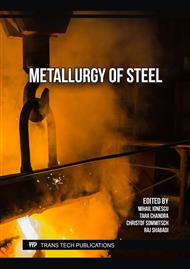[1]
E. De Moor, Advanced high-strength steels for automotive applications, in: R. Rana (Ed.), High-Performance Ferrous Alloys, Springer, New York, 2021, pp.113-151.
DOI: 10.1007/978-3-030-53825-5_4
Google Scholar
[2]
H. K. D. H. Bhadeshia, Bainite in Steels, third ed., CRC Press, Boca Raton, 2015.
Google Scholar
[3]
R. Rana, S. Chen, A. Haldar, S. Das, Mechanical properties of a bainitic steel producible by hot rolling, Arch. Metall. Mater. 62 (2017) 2331-2338.
DOI: 10.1515/amm-2017-0342
Google Scholar
[4]
S. Chen, R. Rana, B. Xiao, A. Haldar, The effects of hot deformation of austenite on the bainitic transformation in a Fe-C-Mn-Si-Cr steel, Mater. Sci. Forum 941 (2018) 486-491.
DOI: 10.4028/www.scientific.net/msf.941.486
Google Scholar
[5]
P. Payson, C. H. Savage, Martensite reactions in alloy steels, Trans. Am. Soc. Mater. 33 (1944) 261-280.
Google Scholar
[6]
Z. Zhao, C. Liu, Y. Liu, D. O. Northwood, A new empirical formula for the bainite upper temperature limit of steel. J. Mater. Sci. 36 (2001) 5045-5056.
Google Scholar
[7]
H. K. D. H. Bhadeshia, D. V. Edmonds, Bainite in silicon steels: new composition–property approach Part 1, Met. Sci. 17 (1983) 411-419.
DOI: 10.1179/030634583790420600
Google Scholar
[8]
D. P. Koistinen, R. E. Marburger, A general equation prescribing the extent of the austenite-martensite transformation in pure iron-carbon alloys and plain carbon steels, Acta Metall. 7 (1959) 59-60.
DOI: 10.1016/0001-6160(59)90170-1
Google Scholar
[9]
A. Eres-Castellanos, I. Toda-Caraballo, A. Latz, F. G. Caballero, C. Garcia-Mateo, An integrated-model for austenite yield strength considering the influence of temperature and strain rate in lean steels, Mater. Des. 188 (2020) 108435.
DOI: 10.1016/j.matdes.2019.108435
Google Scholar
[10]
Z. Yang, C. Chu, F. Jiang, Y. Qin, X. Long, S. Wang, D. Chen, F. Zhang, Accelerating nano-bainite transformation based on a new constructed microstructural predicting model, Mater. Sci. Eng. A 748 (2019) 16-20.
DOI: 10.1016/j.msea.2019.01.061
Google Scholar
[11]
V. V. Zabil'skii, Temper embrittlement of structural alloy steels (review), Met. Sci. Heat Treat. 29 (1987) 32-42.
DOI: 10.1007/bf00735489
Google Scholar
[12]
B. N. P. Babu, M. S. Bhat, E. R. Parker, V. F. Zackay, A rapid magnetometric technique to plot isothermal transformation diagrams, Metall. Trans. A 7A (1976) 17-22.
DOI: 10.1007/bf02644034
Google Scholar
[13]
S. Chen, R. Rana and C. Lahaye, Study of TRIP-aided bainitic ferritic steels produced by hot press forming, Metall. Mater. Trans. A 45 (2014) 2209-2218.
DOI: 10.1007/s11661-013-2163-3
Google Scholar



